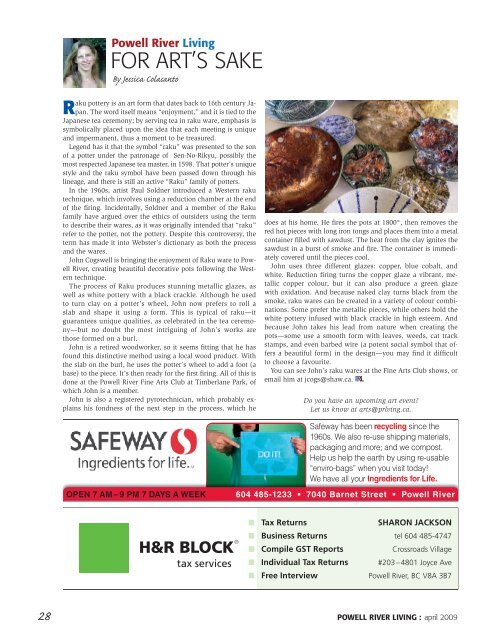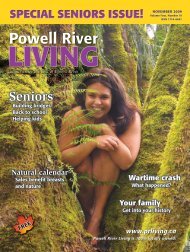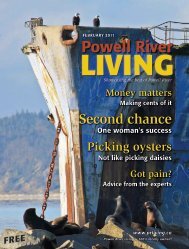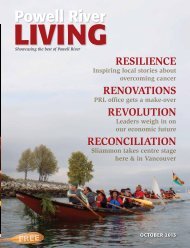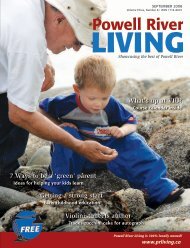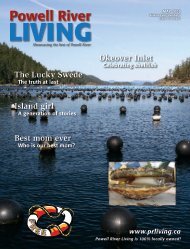Stunning Go for the green Real estate tips Healthy point of VIU
op for... - Powell River Living
op for... - Powell River Living
- No tags were found...
You also want an ePaper? Increase the reach of your titles
YUMPU automatically turns print PDFs into web optimized ePapers that Google loves.
By Jessica Colasanto<br />
Raku pottery is an art <strong>for</strong>m that dates back to 16th century Japan.<br />
The word itself means “enjoyment,” and it is tied to <strong>the</strong><br />
Japanese tea ceremony; by serving tea in raku ware, emphasis is<br />
symbolically placed upon <strong>the</strong> idea that each meeting is unique<br />
and impermanent, thus a moment to be treasured.<br />
Legend has it that <strong>the</strong> symbol “raku” was presented to <strong>the</strong> son<br />
<strong>of</strong> a potter under <strong>the</strong> patronage <strong>of</strong> Sen-No-Rikyu, possibly <strong>the</strong><br />
most respected Japanese tea master, in 1598. That potter’s unique<br />
style and <strong>the</strong> raku symbol have been passed down through his<br />
lineage, and <strong>the</strong>re is still an active “Raku” family <strong>of</strong> potters.<br />
In <strong>the</strong> 1960s, artist Paul Soldner introduced a Western raku<br />
technique, which involves using a reduction chamber at <strong>the</strong> end<br />
<strong>of</strong> <strong>the</strong> firing. Incidentally, Soldner and a member <strong>of</strong> <strong>the</strong> Raku<br />
family have argued over <strong>the</strong> ethics <strong>of</strong> outsiders using <strong>the</strong> term<br />
to describe <strong>the</strong>ir wares, as it was originally intended that “raku”<br />
refer to <strong>the</strong> potter, not <strong>the</strong> pottery. Despite this controversy, <strong>the</strong><br />
term has made it into Webster’s dictionary as both <strong>the</strong> process<br />
and <strong>the</strong> wares.<br />
John Cogswell is bringing <strong>the</strong> enjoyment <strong>of</strong> Raku ware to Powell<br />
River, creating beautiful decorative pots following <strong>the</strong> Western<br />
technique.<br />
The process <strong>of</strong> Raku produces stunning metallic glazes, as<br />
well as white pottery with a black crackle. Although he used<br />
to turn clay on a potter’s wheel, John now prefers to roll a<br />
slab and shape it using a <strong>for</strong>m. This is typical <strong>of</strong> raku—it<br />
guarantees unique qualities, as celebrated in <strong>the</strong> tea ceremony—but<br />
no doubt <strong>the</strong> most intriguing <strong>of</strong> John’s works are<br />
those <strong>for</strong>med on a burl.<br />
John is a retired woodworker, so it seems fitting that he has<br />
found this distinctive method using a local wood product. With<br />
<strong>the</strong> slab on <strong>the</strong> burl, he uses <strong>the</strong> potter’s wheel to add a foot (a<br />
base) to <strong>the</strong> piece. It’s <strong>the</strong>n ready <strong>for</strong> <strong>the</strong> first firing. All <strong>of</strong> this is<br />
done at <strong>the</strong> Powell River Fine Arts Club at Timberlane Park, <strong>of</strong><br />
which John is a member.<br />
John is also a registered pyrotechnician, which probably explains<br />
his fondness <strong>of</strong> <strong>the</strong> next step in <strong>the</strong> process, which he<br />
does at his home. He fires <strong>the</strong> pots at 1800°, <strong>the</strong>n removes <strong>the</strong><br />
red hot pieces with long iron tongs and places <strong>the</strong>m into a metal<br />
container filled with sawdust. The heat from <strong>the</strong> clay ignites <strong>the</strong><br />
sawdust in a burst <strong>of</strong> smoke and fire. The container is immediately<br />
covered until <strong>the</strong> pieces cool.<br />
John uses three different glazes: copper, blue cobalt, and<br />
white. Reduction firing turns <strong>the</strong> copper glaze a vibrant, metallic<br />
copper colour, but it can also produce a <strong>green</strong> glaze<br />
with oxidation. And because naked clay turns black from <strong>the</strong><br />
smoke, raku wares can be created in a variety <strong>of</strong> colour combinations.<br />
Some prefer <strong>the</strong> metallic pieces, while o<strong>the</strong>rs hold <strong>the</strong><br />
white pottery infused with black crackle in high esteem. And<br />
because John takes his lead from nature when creating <strong>the</strong><br />
pots—some use a smooth <strong>for</strong>m with leaves, weeds, cat track<br />
stamps, and even barbed wire (a potent social symbol that <strong>of</strong>fers<br />
a beautiful <strong>for</strong>m) in <strong>the</strong> design—you may find it difficult<br />
to choose a favourite.<br />
You can see John’s raku wares at <strong>the</strong> Fine Arts Club shows, or<br />
email him at jcogs@shaw.ca.<br />
Do you have an upcoming art event?<br />
Let us know at arts@prlving.ca.<br />
Safeway has been since <strong>the</strong><br />
1960s. We also re-use shipping materials,<br />
packaging and more; and we compost.<br />
Help us help <strong>the</strong> earth by using re-usable<br />
“enviro-bags” when you visit today!<br />
We have all your <br />
OPEN 7 AM – 9 PM 7 DAYS A WEEK<br />
<br />
tax services<br />
Tax Returns<br />
Business Returns<br />
Compile GST Reports<br />
Individual Tax Returns<br />
Free Interview<br />
SHARON JACKSON<br />
tel 604 485-4747<br />
Crossroads Village<br />
#203– 4801 Joyce Ave<br />
Powell River, BC V8A 3B7<br />
28 POwEll RIVER lIVINg : april 2009


